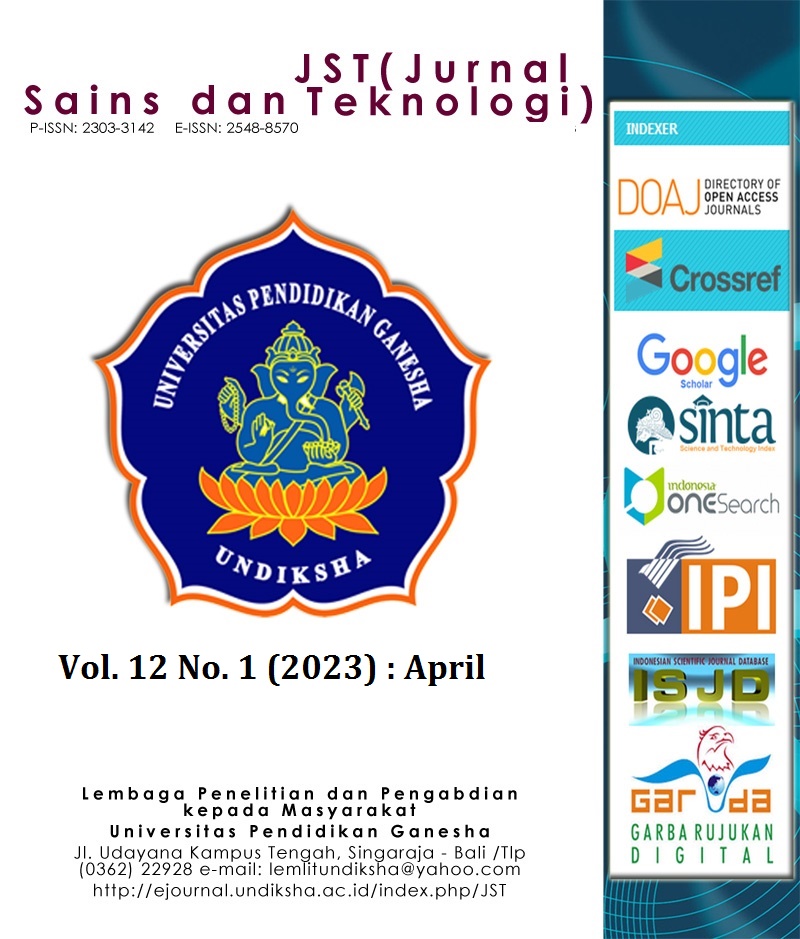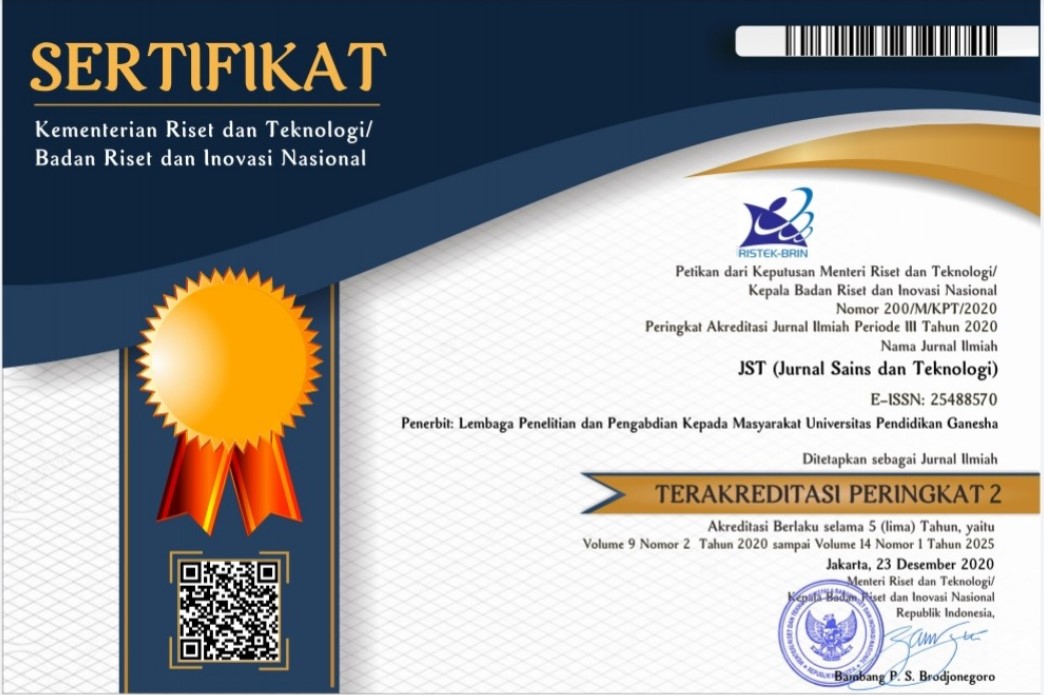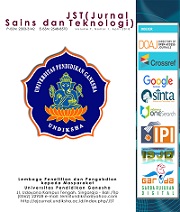Aplikasi E-nose dengan Kemometrik untuk Monitoring Proses Fermentasi Teh Kombucha
DOI:
https://doi.org/10.23887/jstundiksha.v12i1.50994Keywords:
eNose, Gas Sensor, Chemometrics, Fermentation, Kombucha Tea, LDAAbstract
Teh kombucha adalah minuman teh manis hasil fermentasi menggunakaan Symbiotic Culture of Bacteria and Yeast (SCOBY) yang saat ini mulai banyak di produksi dan di konsumsi karena manfaatnya untuk kesehatan. Lamanya proses fermentasi akan berpengaruh terhadap kelayakan dan kualitas teh tersebut untuk dikonsumsi selain menghasilkan aroma yang khas tentunya. Tujuan dari penelitian ini adalah menerapkan electronic nose (E-nose) untuk mempelajari proses fermentasi teh kombucha dengan menggunakan metode linier discriminat analysis (LDA). Percobaan dilakukan selama 12 hari dengan menggunakan enose yang berbasis larik sensor gas dengan menggabungkan metode LDA untuk analisis kemometrik. Hasil LDA menunjukkan pengelompokan data sesuai dengan hari selama proses fermentasi yang sesuai dengan perubahan visual pada teh. Selain itu metode LDA juga menghasilkan tingkat akurasi yang lebih baik dibandingkan dengan metode k-nearest neighbors (KNN), classifcation and regression tree (CART) dalam mengklasifikasi teh kombucha selama proses fermentasi. Sehingga dapat disepakati bahwa e-nose dapat digunakan sebagai alat ukur untuk pemantauan proses fermentasi dan pengujian kualitas teh kombucha.
References
Abu-Khalaf, N., & Masoud, W. (2022). Electronic Nose for Differentiation and Quantification of Yeast Species in White Fresh Soft Cheese. Applied Bionics and Biomechanics. https://doi.org/10.1155/2022/8472661.
Alvian Nugroho, A., Wijaya, W., Hendry, J., & Sumanto, B. (2022). Seleksi Fitur Aroma Teh Kombucha menggunakan ANN untuk Optimasi Kinerja Sistem E-nose. ELKOMIKA, 10(2), 334–349. https://doi.org/10.26760/elkomika.v10i2.334.
Bauer-Petrovska, B., & Petrushevska-Tozi, L. (2000). Mineral and water soluble vitamin content in the Kombucha drink. International Journal of Food Science and Technology, 35(2). https://doi.org/10.1046/j.1365-2621.2000.00342.x.
Bishop, P., Pitts, E. R., Budner, D., & Thompson-Witrick, K. A. (2022). Kombucha: Biochemical and microbiological impacts on the chemical and flavor profile. Food Chemistry Advances, 1. https://doi.org/10.1016/j.focha.2022.100025.
Blanc, P. J. (1996). Characterization of the tea fungus metabolites. Biotechnology Letters, 18(2). https://doi.org/10.1007/BF00128667.
Dutta, H., & Paul, S. K. (2019). Kombucha Drink: Production, Quality, and Safety Aspects. In Production and Management of Beverages. https://doi.org/10.1016/b978-0-12-815260-7.00008-0.
Hidayat, S. N., Nuringtyas, T. R., & Triyana, K. (2018). Electronic Nose Coupled with Chemometrics for Monitoring of Tempeh Fermentation Process. Proceedings - 2018 4th International Conference on Science and Technology,. ICST. https://doi.org/10.1109/ICSTC.2018.8528580.
Hotmaria Simanjuntak, D., & Lestari, D. (2016). FishtecH-Jurnal Teknologi Hasil Perikanan Karakteristik Kimia dan Aktivitas Antioksidan Kombucha dari Tumbuhan Apu-apu (Pistia stratiotes) Selama Fermentasi., 5(2), 123–133.
Inayah, S. N., Nurul, W., Jainudin Heremba, M., Samloy, Y., & Tuapattinaya, P. M. J. (2019). Uji Organoleptik Enhalus Tea Berdasarkan Cara Pengeringan Dan Tingkat Ketuaan Daun Secara Morfologi. Scie Map J, 1(2), 65–72.
Ita Purnami, K., Anom Jambe, A., & Wayan Wisaniyasa, N. (2018). Pengaruh Jenis Teh Terhadap Karakteristik Teh Kombucha. Itepa: Jurnal Ilmu Dan Teknologi Pangan, 7(2). https://doi.org/10.24843/itepa.2018.v07.i02.p01.
Jayabalan, R., Marimuthu, S., & Swaminathan, K. (2007). Changes in content of organic acids and tea polyphenols during kombucha tea fermentation. Food Chemistry, 102(1). https://doi.org/10.1016/j.foodchem.2006.05.032.
Kovacs, Z., Bodor, Z., Zaukuu, J. L. Z., Kaszab, T., Bazar, G., Tóth, T., & Mohácsi-Farkas, C. (2020). Electronic nose for monitoring odor changes of Lactobacillus species during milk fermentation and rapid selection of probiotic candidates. Foods, 9(11). https://doi.org/10.3390/foods9111539.
Kruk, M., Trząskowska, M., Ścibisz, I., & Pokorski, P. (2021). Application of the “scoby” and kombucha tea for the production of fermented milk drinks. Microorganisms, 9(1). https://doi.org/10.3390/microorganisms9010123.
Kuhn, M., & Johnson, K. (2013). Applied predictive modeling. In Applied Predictive Modeling. https://doi.org//10.1007/978-1-4614-6849-3.
Kumar, S. D., Narayan, G., & Hassarajani, S. (2008). Determination of anionic minerals in black and kombucha tea using ion chromatography. Food Chemistry, 111(3). https://doi.org/10.1016/j.foodchem.2008.05.012.
Laavanya, D., Shirkole, S., & Balasubramanian, P. (2021). Current challenges, applications and future perspectives of SCOBY cellulose of Kombucha fermentation. In Journal of Cleaner Production, 295. https://doi.org/10.1016/j.jclepro.2021.126454.
Laureys, D., Britton, S. J., & de Clippeleer, J. (2020). Kombucha Tea Fermentation: A Review. In Journal of the American Society of Brewing Chemists, 78(3). https://doi.org/10.1080/03610470.2020.1734150.
Lazaro, J. B., Ballado, A., Bautista, F. P. F., So, J. K. B., & Villegas, J. M. J. (2018). Chemometric data analysis for black tea fermentation using principal component analysis. In AIP Conference Proceedings (p. 2045). https://doi.org/10.1063/1.5080863.
Leal, J. M., Suárez, L. V., Jayabalan, R., Oros, J. H., & Escalante-Aburto, A. (2018). A review on health benefits of kombucha nutritional compounds and metabolites. CYTA - Journal of Food, 16(1). https://doi.org/10.1080/19476337.2017.1410499.
Li, Y.-X., Lai, H.-M., & Chen, C.-P. (2017). A Scientometric Review of the Current Status and Emerging Trends in Project-Based Learning. International Journal of Information and Education Technology, 7(8), 581–584. https://doi.org/10.18178/ijiet.2017.7.8.935.
Sanaeifar, A., Mohtasebi, S. S., Ghasemi-Varnamkhasti, M., & Ahmadi, H. (2016). Application of MOS based electronic nose for the prediction of banana quality properties. Measurement: Journal of the International Measurement Confederation, 82. https://doi.org/10.1016/j.measurement.2015.12.041.
Saputri, R. K., Al-bari, A., Nahdlatul, U., Sunan, U., & Bojonegoro, G. (2020). Pengaruh Konsumsi Teh dengan Tingkat Obesitas Mahasiswa Farmasi Universitas Nahdlatul Ulama Sunan Gir. ,. Jurnal Penjas Dan Farmasi, 3.
Seesaard, T., & Wongchoosuk, C. (2022). Recent Progress in Electronic Noses for Fermented Foods and Beverages Applications. Fermentation, 8(7), 302. https://doi.org/10.3390/fermentation8070302.
Sharma, P., Ghosh, A., , Tudu, B., Sabhapondit, S., Baruah, B. D., Tamuly, P., Bhattacharyya, N., & Bandyopadhyay, R. (2015). Monitoring the fermentation process of black tea using QCM sensor based electronic nose. Sensors and Actuators, B: Chemical, 219. https://doi.org/10.1016/j.snb.2015.05.013.
Sharmilan, T., Premarathne, I., Wanniarachchi, I., Kumari, S., & Wanniarachchi, D. (2020). Electronic Nose Technologies in Monitoring Black Tea Manufacturing Process. In Journal of Sensors, 2020. https://doi.org/10.1155/2020/3073104
Sharmilan, T., Premarathne, I., Wanniarachchi, I., Kumari, S., & Wanniarachchi, D. (2022). Application of Electronic Nose to Predict the Optimum Fermentation Time for Low-Country Sri Lankan Tea. Journal of Food Quality. https://doi.org/10.1155/2022/7703352.
Triyana, K., Taukhid Subekti, M., Aji, P., Nur Hidayat, S., & Rohman, A. (2015). Development of Electronic Nose with Low-Cost Dynamic Headspace for Classifying Vegetable Oils and Animal Fats. Applied Mechanics and Materials, 771. https://doi.org/10.4028/www.scientific.net/amm.771.50.
Villarreal-Soto, S. A., Beaufort, S., Bouajila, J., Souchard, J. P., & Taillandier, P. (2018). Understanding Kombucha Tea Fermentation: A Review. In Journal of Food Science, 83(3), 580–588. https://doi.org/10.1111/1750-3841.14068.
Wakhid, S., Sarno, R., & Sabilla, S. I. (2022). The effect of gas concentration on detection and classification of beef and pork mixtures using E-nose. Computers and Electronics in Agriculture, 195. https://doi.org/10.1016/j.compag.2022.106838.
Wijaya, D. R., Sarno, R., & Zulaika, E. (2016). Sensor array optimization for mobile electronic nose: Wavelet transform and filter based feature selection approach. International Review on Computers and Software, 11(8). https://doi.org/10.15866/irecos.v11i8.9425.
Wu, Q. J., Dong, Q. H., Sun, W. J., Huang, Y., Wang, Q. Q., & Zhou, W. L. (2014). Discrimination of Chinese teas with different fermentation degrees by stepwise linear discriminant analysis (S-LDA) of the chemical compounds. Journal of Agricultural and Food Chemistry, 62(38). https://doi.org/10.1021/jf5025483.
Yu, D., & Gu, Y. (2021). A machine learning method for the fine-grained classification of green tea with geographical indication using a mos-based electronic nose. Foods, 10(4). https://doi.org/10.3390/foods10040795.
Downloads
Published
How to Cite
Issue
Section
License
Copyright (c) 2022 Budi Sumanto, Yessi Idianingrum TW, Shafura Humaira, Ratna Lestari Budiani, Muhammad Arrofiq

This work is licensed under a Creative Commons Attribution-ShareAlike 4.0 International License.
Authors who publish with the Jurnal Sains dan Teknologi (JST) agree to the following terms:
- Authors retain copyright and grant the journal the right of first publication with the work simultaneously licensed under a Creative Commons Attribution License (CC BY-SA 4.0) that allows others to share the work with an acknowledgment of the work's authorship and initial publication in this journal.
- Authors are able to enter into separate, additional contractual arrangements for the non-exclusive distribution of the journal's published version of the work (e.g., post it to an institutional repository or publish it in a book), with an acknowledgment of its initial publication in this journal.
- Authors are permitted and encouraged to post their work online (e.g., in institutional repositories or on their website) prior to and during the submission process, as it can lead to productive exchanges, as well as earlier and greater citation of published work. (See The Effect of Open Access)
















